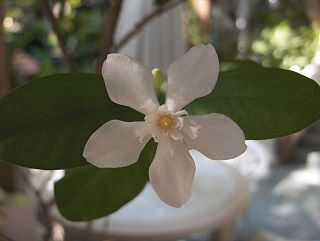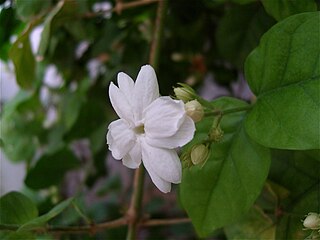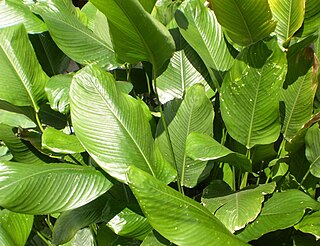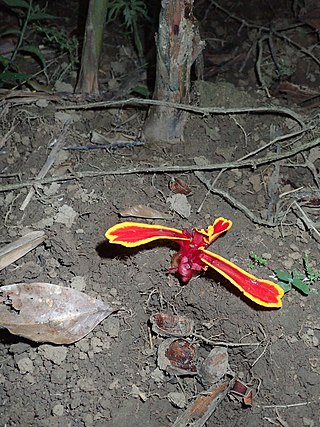
Jasmine is a genus of shrubs and vines in the olive family of Oleaceae. It contains around 200 species native to tropical and warm temperate regions of Eurasia, Africa, and Oceania. Jasmines are widely cultivated for the characteristic fragrance of their flowers. A number of unrelated plants contain the word "jasmine" in their common names.

Ficus religiosa or sacred fig is a species of fig native to the Indian subcontinent and Indochina that belongs to Moraceae, the fig or mulberry family. It is also known as the bodhi tree, pippala tree, peepul tree, peepal tree, pipal tree, ashvattha tree, or Asathu (ඇසතු) in Sinhala The sacred fig is considered to have a religious significance in three major religions that originated on the Indian subcontinent, Hinduism, Buddhism and Jainism. Hindu and Jain ascetics consider the species to be sacred and often meditate under it. This is the tree species under which Gautama Buddha is believed to have attained enlightenment. The sacred fig is the state tree of the Indian states of Odisha, Bihar and Haryana.
Jasmine is a flowering shrub of the genus Jasminum. It may also refer to:

Wrightia is a genus of flowering plants in the family Apocynaceae, first described as a genus in 1810. It native to tropical Africa, China, the Indian Subcontinent, Southeast Asia, Papuasia, and Australia. The species are all small trees or shrubs.

Jasminum sambac is a species of jasmine native to tropical Asia, from the Indian subcontinent to Southeast Asia. It is cultivated in many places, especially West Asia, South Asia and Southeast Asia. It is naturalised in many scattered locales: Mauritius, Madagascar, the Maldives, Christmas Island, Chiapas, Central America, southern Florida, the Bahamas, Cuba, Hispaniola, Jamaica, Puerto Rico, and the Lesser Antilles.

Scaphium affine is a tree species in the family Malvaceae, subfamily Sterculioideae. It is native to mainland Southeast Asia and no subspecies are listed in the Catalogue of Life.

Woodfordia fruticosa is a species of plant in the family Lythraceae.

Jasminum officinale, known as the common jasmine or simply jasmine, is a species of flowering plant in the olive family Oleaceae. It is native to the Caucasus and parts of Asia, also widely naturalized.
Strobilanthes involucrata is a species of flowering plants in the family Acanthaceae and the tribe Ruellieae. It is found in south-east Asia: native to Java and introduced to Indo-China. This was previously considered a species of the monotypic genus Pachystrobilus.

Stachyphrynium placentarium is a species of plant in the family Marantaceae. Its basionym was Phyllodes placentaria Lour. and was subsequently long placed as various species in the genus Phrynium. The species is widespread throughout Asia, with records from Bhutan, southern China, India, Indo-China and Indonesia; no subspecies are listed in the Catalogue of Life.

Phrynium pubinerve is the type species of the plant genus Phrynium, in the family Marantaceae. It is widespread throughout Asia, with records from India, China, and Indo-China through to New Guinea; no subspecies are listed in the Catalogue of Life.
Phrynium imbricatum is a species of plant in the family Marantaceae. It can be found from India through to most of Indo-China; no subspecies are listed in the Catalogue of Life.

Wrightia annamensis is a small tree species in the family Apocynaceae. Its distribution includes: southern China, Cambodia and Viet Nam: where it may be called: lòng mức trung bộ.

Wrightia pubescens is a species of small tree in the family Apocynaceae. Its distribution includes: Australia, southern China, Taiwan (introduced), Indonesia, New Guinea, Philippines and Indo-China. In Viet Nam, it may be called: lòng mức lông.

Wrightia dubia is a species of shrub-plant in the family Apocynaceae. Its distribution includes: Indo-China and peninsular Malaysia ; no subspecies are listed in the Catalogue of Life. In Viet Nam, it may be called lòng mức ngờ.

Etlingera littoralis is a plant in the family Zingiberaceae (gingers), with no subspecies listed in the Catalogue of Life. It is found in lowland tropical forest floors in: Hainan, Indo-China and Malesia.
Streblus taxoides is a species of plant in the family Moraceae, tribe Moreae. It is a medium-sized, spiny bush found in the sub-canopy layer of Asian tropical forests. This species can be found in India, China, Indo-China and Malesia; no subspecies are listed in the Catalogue of Life. It is dioecious, with male and female flowers borne on separate plants.
Capparis acutifolia is a species of shrub in the family Capparaceae. The recorded distribution includes India, China, and Indo-China. It may be called cáp xoan ngược in Vietnam.

Ficus heterophylla is a fig plant species, in the family Moraceae, which can be found in India, southern China, Indo-China and western Malesia. In Vietnam it may be called vú bò.

Bouea is an Asian genus of fruiting trees in the family Anacardiaceae. Species can be found in southern China, Indo-China and Malesia.



















